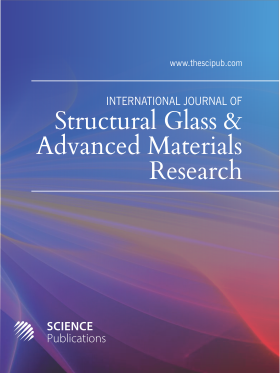Effect of Various Combustible Materials on Insulating Properties of Refractory Bricks
- 1 Afikpo, Ebonyi State, Nigeria
- 2 Enugu State University of Science and Technology Enugu, Nigeria
- 3 Ile-Ife, Nigeria
- 4 Achievers University Owo, Ondo state, Nigeria
Abstract
The effect of various combustible materials on insulating properties of refractory bricks produced from Enugu fire clay and Ekebedi clay has been studied. This is aimed at determining the most favourable combustible material for different composition(s). The clays with combustible materials were used to compose different samples labeled A-G with varying percentages of combustible materials at reducing rate of 5% from 40 to 10%. The combustible materials used were paper pulp, saw dust, rice husk and cow dung. Properly mixed bodies with required moisture content were hydraulically pressed into shape and the bricks were oven-dried at temperature of ±110°C. The properties of the produced insulating bricks were investigated after sintering at 1300°C. The results indicated that samples A-G of the products had % shrinkage ranging from 18 - 4.1% with corresponding bulk density of 0.57-1.29 g/cm3 respectively. The investigation revealed that samples of the bricks as stated above had crushing strength ranging from 0.008-16.05 MPa with corresponding percentage porosity ranging from 85.71-19.75% respectively. The estimated refractoriness using shuen’s formula revealed that samples A-G had 1004.6-1506.8°C range of refractoriness while the result of the refractoriness using Pyrometric Cone Equivalent (PCE) indicated that samples A-G had cone 05A (1010°C) - cone 19 (1520°C) range of refractoriness. Spalling count test result revealed that samples A-G of bricks as stated above had number of cycles ranging from 31-8 respectively. It was discovered that the higher the combustible materials the higher the shrinkage, porosity and spalling count cycles while the lower the bulk density and crushing strength of the bricks. Samples of the insulating bricks produced with rice husk gave the most favourable result when considered against the properties stated above. Therefore, 30 and 25% (samples C and D) of the rice husk can be used as combustible material for mass production of insulating bricks.
DOI: https://doi.org/10.3844/sgamrsp.2020.168.179

- 2,970 Views
- 1,687 Downloads
- 0 Citations
Download
Keywords
- Insulating Brick
- Pore Formers
- Refractory
- Refractoriness
